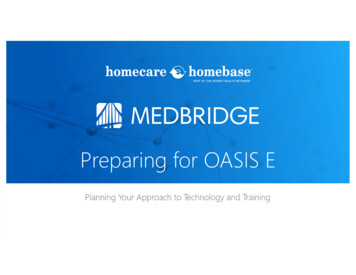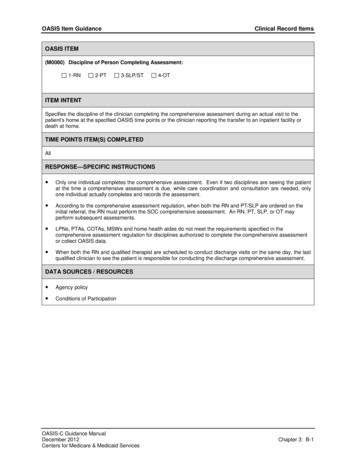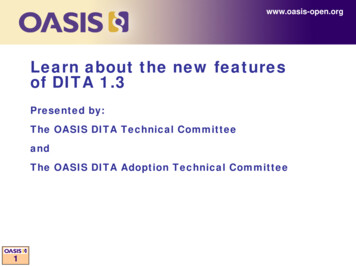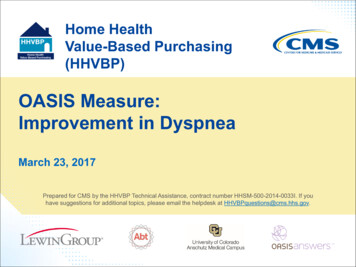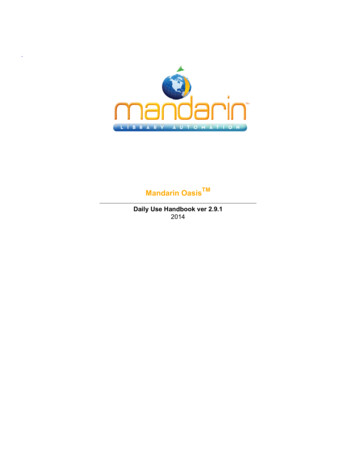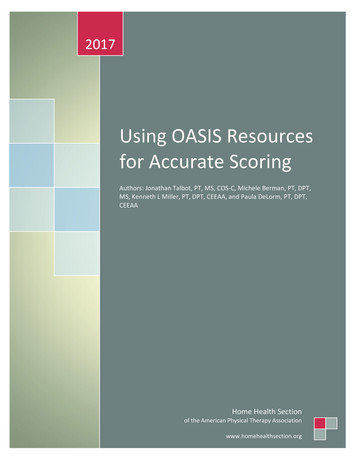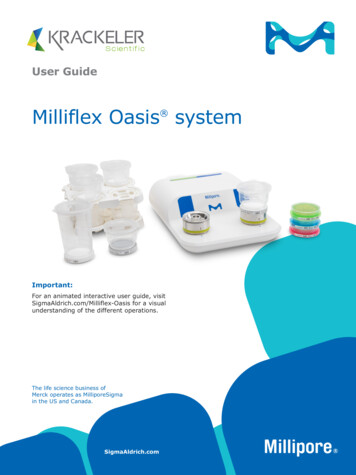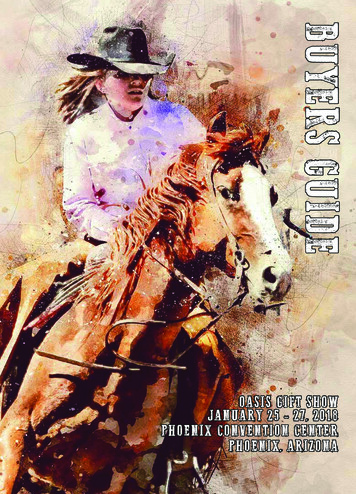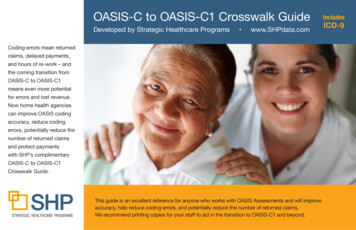
Transcription
OASIS-C to OASIS-C1 Crosswalk GuideDeveloped by Strategic Healthcare Programs www.SHPdata.comCoding errors mean returnedclaims, delayed payments,and hours of re-work – andthe coming transition fromOASIS-C to OASIS-C1means even more potentialfor errors and lost revenue.Now home health agenciescan improve OASIS codingaccuracy, reduce codingerrors, potentially reduce thenumber of returned claimsand protect paymentswith SHP’s complimentaryOASIS-C to OASIS-C1Crosswalk Guide.This guide is an excellent reference for anyone who works with OASIS Assessments and will improveaccuracy, help reduce coding errors, and potentially reduce the number of returned claims.We recommend printing copies for your staff to aid in the transition to OASIS-C1 and beyond.IncludesICD-9
OASIS-C to OASIS-C1/ICD-9 & OASIS-C1/ICD-10 Crosswalk GuideDeveloped by Strategic Healthcare Programs www.SHPdata.comSHP is pleased to provide home health agencies with a complete side-by-side comparison of the OASIS-C and OASIS-C1 assessment forms. Color-coded indicators highlight any M-items that have beenadded, removed, or changed between the two OASIS versions (see the key below). This document includes all M-items recorded at start of care (SOC), resumption of care (ROC), follow-up (FU), transfer(TRF), and at discharge (DC). Next to each M-item is a box listing all assessment reasons (SOC, ROC, FU, TRF, DC) at which each item is recorded.This guide is an excellent reference for anyone who works with OASIS Assessments and will improve accuracy, help reduce coding errors, and potentially reduce the number of returned claims. Werecommend printing copies for your staff to aid in the transition to OASIS-C1 and beyond.Outcome and Assessment Information Set (OASIS-C)Outcome and Assessment Information Set (OASIS-C1)Items to be Used at Specific Time PointsItems to be Used at Specific Time PointsStart of Care --------- M0010-M0030, M0040- M0150, M1000-M1036, M1100M1242, M1300-M1302, M1306, M1308-M1324, M1330Start of care—further visits plannedM1350, M1400, M1410, M1600-M1730, M1740-M1910,M2000, M2002, M2010, M2020-M2250Start of Care --------- M0010-M0030, M0040-M0150, M1000-M1036, M1100M1306, M1308, M1320-M1410, M1600-M2002, M2010,Start of care—further visits plannedM2020-M2250Resumption of Care ------------------------------------------------ M0032, M0080-M0110, M1000-M1036, M1100-M1242,M1300-M1302, M1306, M1308-M1324, M1330-M1350,Resumption of care (after inpatient stay)M1400, M1410, M1600-M1730, M1740-M1910, M2000,M2002, M2010, M2020-M2250Resumption of Care ------------------------------------------------ M0032, M0080-M0110, M1000-M1036, M1100-M1306,M1308, M1320-M1410, M1600-M2002, M2010, M2020Resumption of care (after inpatient stay)M2250Follow-Up ------------ M0080-M0100, M0110, M1020-M1030, M1200, M1242,M1306, M1308, M1322-M1324, M1330-M1350, M1400,Recertification (follow-up) assessmentM1610, M1620, M1630, M1810-M1840, M1850, M1860,Other follow-up assessmentM2030, M2200Follow-Up ------------ M0080-M0100, M0110, M1011, M1021-M1030, M1200,M1242, M1306, M1308, M1322-M1342, M1400, M1610,Recertification (follow-up) assessmentM1620, M1630, M1810-M1840, M1850, M1860, M2030,Other follow-up assessmentM2200Transfer to an Inpatient Facility --------------------------------- M0080-M0100, M1040-M1055, M1500, M1510, M2004,M2015, M2300-M2410, M2430-M2440, M0903, M0906Transferred to an inpatient facility—patient notdischarged from an agencyTransferred to an inpatient facility—patientdischarged from agencyTransfer to an Inpatient Facility --------------------------------- M0080-M0100, M1041-M1056, M1500, M1510, M2004,M2015, M2300-M2410, M2430, M0903, M0906Transferred to an inpatient facility—patient notdischarged from an agencyTransferred to an inpatient facility—patientdischarged from agencyDischarge from Agency — Not to an Inpatient FacilityDischarge from Agency — Not to an Inpatient FacilityDeath at home -- M0080-M0100, M0903, M0906Discharge from agency----------------------------------------- M0080-M0100, M1041-M1056, M1230, M1242, M1306M1342, M1400, M1500-M1620, M1700-M1720, M1740,M1745, M1800-M1890, M2004, M2015-M2030, M2102,M2300-M2420, M0903, M0906Death at home -- M0080-M0100, M0903, M0906Discharge from agency----------------------------------------- M0080-M0100, M1040-M1055, M1230, M1242, M1306M1350, M1400-M1620, M1700-M1720, M1740, M1745,M1800-M1890, M2004, M2015-M2030, M2100-M2110,M2300-M2420, M0903, M0906KEYNewChangedOmittedNo changeNote:This version of OASIS-C1 is current with the OASIS Data Submission Specifications 2.11.0: DRAFTNote that OASIS-C1 is being implemented in two phases, OASIS-C1/ICD-9 on 1/1/2015 followed byOASIS-C1/ICD-10 on 10/1/2015. The ICD-10 version initiates use of ICD-10 codes and replaces theICD-9 based items (M1010, M1016, M1020, M1022, M1024) with their ICD-10 equivalents (M1011,M1017, M1021, M1023, M1025). These m-items are indicated in the crosswalk document. Thereare no other differences between the two OASIS-C1 versions.This guide is provided by SHP as a service and is for informational use only. Home health agenciesshould always consult CMS.gov for future changes.
CLINICAL RECORD ITEMSCLINICAL RECORD ITEMS⃞ 2-PT⃞ 3-SLP/ST(M0090) Date Assessment Completed:⃞ 4-OT/⃞ 1-RN/month / day /(M0080) Discipline of Person Completing Assessment:ALL⃞ 2-PT⃞ 3-SLP/ST(M0090) Date Assessment Completed:year(M0100) This Assessment is Currently Being Completed for the Following Reason:Start/Resumption of Care⃞ 1 – Start of care—further visits planned⃞ 3 – Resumption of care (after inpatient stay)//month / day /ALLALL⃞ 4-OTALLyear(M0100) This Assessment is Currently Being Completed for the Following Reason:Start/Resumption of Care⃞ 1 – Start of care—further visits planned⃞ 3 – Resumption of care (after inpatient stay)⃞⃞Follow-Up4 – Recertification (follow-up) reassessment [ Go to M0110 ]5 – Other follow-up [ Go to M0110 ]⃞⃞Follow-Up4 – Recertification (follow-up) reassessment [ Go to M0110 ]5 – Other follow-up [ Go to M0110 ]⃞⃞Transfer to an Inpatient Facility6 – Transferred to an inpatient facility—patient not discharged from agency [ Go to M1040]7 – Transferred to an inpatient facility—patient discharged from agency [ Go to M1040 ]⃞⃞Transfer to an Inpatient Facility6 – Transferred to an inpatient facility—patient not discharged from agency [ Go to M1041 ]7 – Transferred to an inpatient facility—patient discharged from agency [ Go to M1041 ]⃞⃞Discharge from Agency — Not to an Inpatient Facility8 – Death at home [ Go to M0903 ]9 – Discharge from agency [ Go to M1040 ]⃞⃞Discharge from Agency — Not to an Inpatient Facility8 – Death at home [ Go to M0903 ]9 – Discharge from agency [ Go to M1041 ](M0102) Date of Physician-ordered Start of Care (Resumption of Care): If the physician indicated a specific startof care (resumption of care) date when the patient was referred for home health services, record the datespecified.//(Go to M0110, if date entered)month / day / yearSOCROC⃞ NA –No specific SOC date ordered by physician(M0104) Date of Referral: Indicate the date that the written or verbal referral for initiation or resumption of carewas received by the HHA.⃞ 2 - Later⃞ UK - Unknown⃞ NA - Not Applicable: No Medicare case mix group to be defined by this assessment.SOCROC⃞ NA –No specific SOC date ordered by physicianSOCROC//month / day / year(M0110) Episode Timing: Is the Medicare home health payment episode for which this assessment will define a casemix group an “early” episode or a “later” episode in the patient’s current sequence of adjacent Medicare homehealth payment episodes?⃞ 1 - Early(M0102) Date of Physician-ordered Start of Care (Resumption of Care): If the physician indicated a specific startof care (resumption of care) date when the patient was referred for home health services, record the datespecified.[ Go to M0110, if date entered ]//month / day / yearALL(M0104) Date of Referral: Indicate the date that the written or verbal referral for initiation or resumption of carewas received by the HHA.SOCROC//month / day / yearSOCROCFU(M0110) Episode Timing: Is the Medicare home health payment episode for which this assessment will define a casemix group an “early” episode or a “later” episode in the patient’s current sequence of adjacent Medicare homehealth payment episodes?⃞ 1 - EarlySOCROCFU⃞ 2 - Later⃞ UK - Unknown⃞ NA - Not Applicable: No Medicare case mix group to be defined by this assessment.2⃞ 1-RNALLPage(M0080) Discipline of Person Completing Assessment:
PATIENT HISTORY AND DIAGNOSESPATIENT HISTORY AND DIAGNOSES(M1000) From which of the following Inpatient Facilities was the patient discharged during the past 14 days?(Mark all that apply.)⃞ 1⃞ 2⃞ 3⃞ 4⃞ 5⃞ 6⃞ 7⃞ NA-Long-term nursing facility (NF)-Skilled nursing facility (SNF / TCU)-Short-stay acute hospital (IPP S)-Long-term care hospital (LTCH)-Inpatient rehabilitation hospital or unit (IRF)-Psychiatric hospital or unit-Other (specify)-Patient was not discharged from an inpatient facility [Go to M1016]SOCROC/month / day /⃞ 1⃞ 2⃞ 3⃞ 4⃞ 5⃞ 6⃞ 7⃞ NASOCROC(M1005) Inpatient Discharge Date (most recent):/(M1000) From which of the following Inpatient Facilities was the patient discharged within the past 14 days?(Mark all that apply.)Short-stay acute hospital (IPP S)-Long-term care hospital (LTCH)-Inpatient rehabilitation hospital or unit (IRF)-Psychiatric hospital or unit-Other (specify)-Patient was not discharged from an inpatient facility [Go to M1017]SOCROC/yearSOCROC(M1011) List each Inpatient Diagnosis and ICD-10-C M code at the level of highest specificity for only thoseconditions actively treated during an inpatient stay having a discharge date within the last 14 days(no V, W, X, Y, or Z codes or surgical codes):Inpatient Facility DiagnosisICD-9-C M Code.(M1012) List each Inpatient Procedure and the associated ICD-9-C M procedure code relevant to the plan of care.Procedure CodeICD-10-C M Code.a.b.c.d.e.f.SOCROCFU.⃞ NA -Not applicable (patient was not discharged from an inpatient facility) [Omit ―NA option on SOC,ROC]OASIS-C1/ICD-10 Change (effective 10/1/2015)OASIS-C1/ICD-10 Change (effective 10/1/2015)-SOCROC⃞ UK - UnknownAdd’lResp.OmittedSkilled nursing facility (SNF / TCU)month / day /(M1010) List each Inpatient Diagnosis and ICD-9-C M code at the level of highest specificity for only those conditionstreated during an inpatient stay within the last 14 days (no E-codes, or V-codes):Inpatient Procedure-/⃞ UK - Unknowna.b.c.d.e.f.Long-term nursing facility (NF)(M1005) Inpatient Discharge Date (most recent):yearInpatient Facility Diagnosis-SOCROC.a.b.c.d.(M1016) Diagnoses Requiring Medical or Treatment Regimen Change Within Past 14 Days: List the patient'sMedical Diagnoses and ICD-9-C M codes at the level of highest specificity for those conditions requiringchanged medical or treatment regimen within the past 14 days (no surgical, E-codes, or V-codes):Changed Medical Regimen Diagnosisa.b.c.d.e.f.SOCROC(M1017) Diagnoses Requiring Medical or Treatment Regimen Change Within Past 14 Days: List the patient'sMedical Diagnoses and ICD-10-C M codes at the level of highest specificity for those conditions requiringchanged medical or treatment regimen within the past 14 days (no V, W, X, Y, or Z codes or surgical codes):Changed Medical Regimen DiagnosisICD-9-C M Code.⃞ NA - Not applicable (no medical or treatment regimen changes within the past 14 days)a.b.c.d.e.f.ICD-10-C M Code.⃞ NA - Not applicable (no medical or treatment regimen changes within the past 14 days)SOCROCOASIS-C1/ICD-10 Change (effective 10/1/2015)OASIS-C1/ICD-10 Change (effective 10/1/2015)⃞ NA - Not applicable⃞ UK - Unknown
Urinary incontinenceIndwelling/suprapubic catheterSOCROCIntractable painImpaired decision-makingDisruptive or socially inappropriate behaviorMemory loss to the extent that supervision requiredNone of the aboveNo inpatient facility discharge and no change in medical or treatment regimen in past 14 daysUnknownUrinary incontinenceIndwelling/suprapubic catheterSOCROCIntractable painImpaired decision-makingDisruptive or socially inappropriate behaviorMemory loss to the extent that supervision requiredNone of the aboveNo inpatient facility discharge and no change in medical or treatment regimen in past 14 daysUnknown(M1021/1023/1025) Diagnoses, Symptom Control, and Optional Diagnoses: List each diagnosis for which thepatient is receiving home care in Column 1, and enter its ICD-10-C M code at the level of highest specificity in Column2 (diagnosis codes only - no surgical or procedure codes allowed). Diagnoses are listed in the order that best reflectsthe seriousness of each condition and supports the disciplines and services provided. Rate the degree of symptomcontrol for each condition in Column 2. ICD-10-C M sequencing requirements must be followed if multiple coding isindicated for any diagnoses. If a Z-code is reported in Column 2 in place of a diagnosis that is no longer active (aresolved condition), then optional item M1025 (Optional Diagnoses - Columns 3 and 4) may be completed Diagnosesreported in M1025 will not impact payment.Code each row according to the following directions for each column:Code each row according to the following directions for each column. Review the OASIS Guidance Manual foradditional directions on how to complete M1021, M1023 and M1025.Column 1:Enter the description of the diagnosis.Column 1:Enter the description of the diagnosis. Sequencing of diagnoses should reflect the seriousness ofeach condition and support the disciplines and services provided.Column 2:Enter the ICD-9-C M code for the diagnosis described in Column 1;Column 2:Enter the ICD-10-C M code for the condition described in Column 1 - no surgical or procedure codesallowed. Codes must be entered at the level of highest specificity and ICD-10-C M coding rules andsequencing requirements must be followed. Note that external cause codes (ICD-10-C M codes beginningwith V, W, X, or Y) may not be reported in M1021 (Primary Diagnosis) but may be reported in M1023(Secondary Diagnoses). Also note that when a Z-code is reported in Column 2, the code for theunderlying condition can often be entered in Column 2, as long as it is an active on-going conditionimpacting home health care.SomeInstruc.ChangeRate the degree of symptom control for the condition listed in Column 1. Choose one value thatrepresents the degree of symptom control appropriate for each diagnosis using the following scale:0 - Asymptomatic, no treatment needed at this time1 - Symptoms well controlled with current therapy2 - Symptoms controlled with difficulty, affecting daily functioning; patient needs ongoing monitoring3 - Symptoms poorly controlled; patient needs frequent adjustment in treatment and dose monitoring4 - Symptoms poorly controlled; history of re-hospitalizationsRate the degree of symptom control for the condition listed in Column 1 using the following scale:0 - Asymptomatic, no treatment needed at this time1 - Symptoms well controlled with current therapy2 - Symptoms controlled with difficulty, affecting daily functioning; patient needs ongoing monitoring3 - Symptoms poorly controlled; patient needs frequent adjustment in treatment and dose monitoring4 - Symptoms poorly controlled; history of re-hospitalizationsNote that the rating for symptom control in Column 2 should not be used to determine the sequencingof the diagnoses listed in Column 1. These are separate items and sequencing may not coincide.Note that in Column 2 the rating for symptom control of each diagnosis should not be used to determine thesequencing of the diagnoses listed in Column 1. These are separate items and sequencing may not coincide.Sequencing of diagnoses should reflect the seriousness of each condition and support the disciplines andservices provided.Column 3: (OPTIONAL) If a V-code is assigned to any row in Column 2, in place of a case mix diagnosis, it may benecessary to complete optional item M1024 Payment Diagnoses (Columns 3 and 4). See OASIS-C GuidanceManual.Column 4: (OPTIONAL) If a V-code in Column 2 is reported in place of a case mix diagnosis that requires multiplediagnosis codes under ICD-9-C M coding guidelines, enter the diagnosis descriptions and the ICD-9-C M codesin the same row in Columns 3 and 4. For example, if the case mix diagnosis is a manifestation code, record thediagnosis description and ICD-9-C M code for the underlying condition in Column 3 of that row and the diagnosisdescription and ICD-9-C M code for the manifestation in Column 4 of that row. Otherwise, leave Column 4 blank in thatrow.Column 3:OASIS-C1/ICD-10 Change (effective 10/1/2015)OASIS-C1/ICD-10 Change (effective 10/1/2015)(M1020/1022/1024) Diagnoses, Symptom Control, and Payment Diagnoses: List each diagnosis for which thepatient is receiving home care (Column 1) and enter its ICD-9-C M code at the level of highest specificity (nosurgical/procedure codes) (Column 2). Diagnoses are listed in the order that best reflect the seriousness of each conditionand support the disciplines and services provided. Rate the degree of symptom control for each condition (Column 2).Choose one value that represents the degree of symptom control appropriate for each diagnosis: V- codes (for M1020 orM1022) or E-codes (for M1022 only) may be used. ICD-9-C M sequencing requirements must be followed if multiple codingis indicated for any diagnoses. If a V-code is reported in place of a case mix diagnosis, then optional item M1024 PaymentDiagnoses (Columns 3 and 4) may be completed. A case mix diagnosis is a diagnosis that determines the Medicare P P Scase mix group. Do not assign symptom control ratings for V- or E- codes.⃞ 1 ⃞ 2 ⃞ 3 ⃞ 4 ⃞ 5 ⃞ 6 ⃞ 7 ⃞ NA ⃞ UK -(OPTIONAL) There is no requirement that HHAs enter a diagnosis code in M1025 (Columns 3 and 4).Diagnoses reported in M1025 will not impact payment.Agencies may choose to report an underlying condition in M1025 (Columns 3 and 4) when: a Z-code is reported in Column 2 AND the underlying condition for the Z-code in Column 2 is a resolved condition . An example of aresolved condition is uterine cancer that is no longer being treated following a hysterectomy.Column 4:(OPTIONAL) If a Z-code is reported in M1021/M1023 (Column 2) and the agency chooses to report aresolved underlying condition that requires multiple diagnosis codes under ICD-10-C M codingguidelines, enter the diagnosis descriptions and the ICD-10-C M codes in the same row in Columns 3and 4. For example, if the resolved condition is a manifestation code, record the diagnosis descriptionand ICD-10-C M code for the underlying condition in Column 3 of that row and the diagnosis descriptionand ICD-10-C M code for the manifestation in Column 4 of that row. Otherwise, leave Column 4 blankin that row.4⃞ 1 ⃞ 2 ⃞ 3 ⃞ 4 ⃞ 5 ⃞ 6 ⃞ 7 ⃞ NA ⃞ UK -(M1018) Conditions Prior to Medical or Treatment Regimen Change or Inpatient Stay Within Past 14 Days: If this patientexperienced an inpatient facility discharge or change in medical or treatment regimen within the past 14 days, indicate anyconditions that existed prior to the inpatient stay or change in medical or treatment regimen. (Mark all that apply.)Page(M1018) Conditions Prior to Medical or Treatment Regimen Change or Inpatient Stay Within Past 14 Days: If thispatient experienced an inpatient facility discharge or change in medical or treatment regimen within the past 14 days, indicateany conditions which existed prior to the inpatient stay or change in medical or treatment regimen. (Mark all that apply.)
Description(M1020) Primary Diagnosisa.(M1022) Other Diagnosesb.c.d.e.f.Column 3Column 4Complete if a V-code isassigned under certaincircumstances to Column 2in place of a case mixdiagnosis.Complete only if the V-codein Column 2 is reported inplace of a case mixdiagnosis that is a multiplecoding situation (e.g., amanifestation code).ICD-9-C M /Symptom Control RatingDescription/ICD-9-C MDescription/ICD-9-C M(V-codes are allowed)a. (.(V- or E-codes NOT allowed) (V- or E-codes NOT allowed))a.⃞0 ⃞1 ⃞2 ⃞3 ⃞4(V- or E-codes are allowed)b. (.)( . ).)b.)c.).)⃞0 ⃞1 ⃞2 ⃞3 ⃞4(M1021) Primary Diagnosis & (M1023) Other DiagnosesColumn 2Column 3Column 4Diagnoses (Sequencing ofdiagnoses should reflect theseriousness of each conditionand support the disciplines andservices provided.)ICD-10-C M and symptomcontrol rating for each condition.Note that the sequencing ofthese ratings may not match thesequencing of the diagnosesMay be completed if a Zcode is assigned to Column2 and the underlyingdiagnosis is resolvedComplete only if the OptionalDiagnosis is a multiple codingsituation (for example: amanifestation code)Description(M1021) Primary Diagnosisa.e.( . )(M1023) Other Diagnosesb.c.d.e.( . )f.( . )f.( . )V, W, X, Y codesNOT alloweda. ( . )⃞0 ⃞1 ⃞2 ⃞3 ⃞4d.( . )ICD-10-C M /Symptom Control RatingAll ICD-10–C M codes allowedb. ( . )⃞0 ⃞1 ⃞2 ⃞3 ⃞4( . )( . )(M1025) Optional Diagnoses (OPTIONAL)(not used for payment)Columc.d.⃞0 ⃞1 ⃞2 ⃞3 ⃞4f. (( . )( . )⃞0 ⃞1 ⃞2 ⃞3 ⃞4e. (b.( . )⃞0 ⃞1 ⃞2 ⃞3 ⃞4d. (( . )(V- or E-codes NOT allowed) (V- or E-codes NOT allowed)⃞0 ⃞1 ⃞2 ⃞3 ⃞4c. (a.SOCROCFUe.f.c. ( . )⃞0 ⃞1 ⃞2 ⃞3 ⃞4d. ( . )⃞0 ⃞1 ⃞2 ⃞3 ⃞4e. ( . )⃞0 ⃞1 ⃞2 ⃞3 ⃞4f. ( . )⃞0 ⃞1 ⃞2 ⃞3 ⃞4Description/ICD-10-C MV, W, X, Y codesNOT alloweda.( . )V, W, X, Y codesNOT allowedb.( . )Description/ICD-10-C MV, W, X, Y codesNOT alloweda.( . )V, W, X, Y codesNOT allowedb.( . )c.c.( . )( . )d.( . )e.( . )f.( . )SOCROCFUOASIS-C1/ICD-10 Change (effective 10/1/2015)OASIS-C1/ICD-10 Change (effective 10/1/2015)Diagnoses (Sequencing ofdiagnoses should reflect theseriousness of each condition andsupport the disciplines andservices provided.)(M1024) Payment Diagnoses (OPTIONAL)Column 2ICD-9-C M and symptomcontrol rating for eachcondition.Note that the sequencing ofthese ratings may not matchthe sequencing of thediagnosesd.( . )e.( . )f.( . )5Column 1Page(M1020) Primary Diagnosis & (M1022) Other Diagnoses
(M1030) Therapies the patient receives at home: (Mark all that apply.)SOCROCFU1 -Intravenous or infusion therapy (excludes TPN)2 -Parenteral nutrition (TPN or lipids)3 -⃞4 -Enteral nutrition (nasogastric, gastrostomy, jejunostomy, or any other artificial entry into thealimentary canal)None of the above(M1032) Risk for Hospitalization: Which of the following signs or symptoms characterize this patient as at risk forhospitalization? (Mark all that apply.)⃞⃞⃞⃞⃞⃞⃞1 -Recent decline in mental, emotional, or behavioral status2 -Multiple hospitalizations (2 or more) in the past 12 months3 -History of falls (2 or more falls - or any fall with an injury - in the past year)4 -Taking five or more medications5 -Frailty indicators, e.g., weight loss, self-reported exhaustion6 -Other7 -None of the aboveResponse 5 broken out into 2 & 8(M1034) Overall Status: Which description best fits the patient’s overall status? (Check one)⃞0 -⃞1 -⃞2 -SOCROCThe patient is stable with no heightened risk(s) for serious complications and death (beyondthose typical of the patient’s age).The patient is temporarily facing high health risk(s) but is likely to return to being stable withoutheightened risk(s) for serious complications and death (beyond those typical of the patient’s age).The patient is likely to remain in fragile health and have ongoing high risk(s) of seriouscomplications and death.The patient has serious progressive conditions that could lead to death within a year.SOCROC⃞ 3 ⃞ UK - The patient’s situation is unknown or unclear.(M1036) Risk Factors, either present or past, likely to affect current health status and/or outcome: (Mark all thatapply.)SOCROC⃞ 1 - Smoking⃞ 2⃞ 3⃞ 4⃞ 5⃞ UK-Obesity-Alcohol dependency-Drug dependency-None of the above-Unknown⃞⃞⃞1 -Intravenous or infusion therapy (excludes TPN)2 -Parenteral nutrition (TPN or lipids)3 -⃞4 -Enteral nutrition (nasogastric, gastrostomy, jejunostomy, or any other artificial entry into thealimentary canal)None of the above(M1033) Risk for Hospitalization: Which of the following signs or symptoms characterize this patient as at risk forhospitalization? (Mark all that apply.)Updated& Add’lResp.⃞⃞⃞⃞⃞⃞1-2-Unintentional weight loss of a total of 10 pounds or more in the past 12 months3-Multiple hospitalizations (2 or more) in the past 6 months4-Multiple emergency department visits (2 or more) in the past 6 months5-Decline in mental, emotional, or behavioral status in the past 3 months6-Reported or observed history of difficulty complying with any medical instructions (for example,medications, diet, exercise) in the past 3 months⃞⃞⃞⃞78-Currently taking 5 or more medicationsCurrently reports exhaustion9 10 -0 -⃞1 -⃞2 -SOCROCHistory of falls (2 or more falls - or any fall with an injury - in the past 12 months)Other risk(s) not listed in 1 - 8None of the above(M1034) Overall Status: Which description best fits the patient’s overall status? (Check one)⃞SOCROCFUThe patient is stable with no heightened risk(s) for serious complications and death (beyondthose typical of the patient’s age).The patient is temporarily facing high health risk(s) but is likely to return to being stable withoutheightened risk(s) for serious complications and death (beyond those typical of the patient’s age).The patient is likely to remain in fragile health and have ongoing high risk(s) of seriouscomplications and death.The patient has serious progressive conditions that could lead to death within a year.SOCROC⃞ 3 ⃞ UK - The patient’s situation is unknown or unclear.(M1036) Risk Factors, either present or past, likely to affect current health status and/or outcome: (Mark all thatapply.)SOCROC⃞ 1 - Smoking⃞ 2⃞ 3⃞ 4⃞ 5⃞ UK-Obesity-Alcohol dependency-Drug dependency-None of the above-Unknown6⃞⃞⃞Page(M1030) Therapies the patient receives at home: (Mark all that apply.)
(M1040) Influenza Vaccine: Did the patient receive the influenza vaccine from your agency for this year’s influenzaseason (October 1 through March 31) during this episode of care?⃞ 0 - No⃞ 1 - Yes [ Go to M1050 ]⃞ NA - Does not apply because entire episode of care (SOC/ROC to Transfer/Discharge) is outside thisTRFDC(M1041) Influenza Vaccine Data Collection Period: Does this episode of care (SOC/ROC to Transfer/Discharge)include any dates on or between October 1 and March 31?Reworked ⃞⃞0 -No [ Go to M1051 ]1 -YesTRFDCinfluenza season. [ Go to M1050 ](M1045) Reason Influenza Vaccine not received: If the patient did not receive the influenza vaccine from your agencyduring this episode of care, state reason:-Received from another health care provider (e.g., physician)Received from your agency previously during this year’s flu seasonOffered and declinedAssessed and determined to have medical contraindication(s)Not indicated; patient does not meet age/condition guidelines for influenza vaccineInability to obtain vaccine due to declared shortageNone of the above(M1050) Pneumococcal Vaccine: Did the patient receive pneumococcal polysaccharide vaccine (PPV) from youragency during this episode of care (SOC/ROC to Transfer/Discharge)?⃞⃞0 -No1 -Yes [ Go to M1500 at TRN; Go to M1230 at DC ](M1055) Reason PPV not received: If patient did not receive the pneumococcal polysaccharide vaccine (PPV)from your agency during this episode of care (SOC/ROC to Transfer/Discharge), state reason:⃞⃞⃞⃞⃞1 -Patient has received PPV in the past2 3 4 -Offered and declinedAssessed and determined to have medical contraindication(s)Not indicated; patient does not meet age/condition guidelines for PPV5 -None of the aboveTRFDCTRFDC12345678-Yes; received from your agency during this episode of care (SOC/ROC to Transfer/Discharge)Yes; received from your agency during a prior episode of care (SOC/ROC to Transfer/Discharge)Yes; received from another health care provider (for example: physician, pharmacist)No; patient offered and declinedNo; patient assessed and determined to have medical contraindication(s)No; not indicated - patient does not meet age/condition guidelines for influenza vaccineNo; inability to obtain vaccine due to declared shortageNo; patient did not receive the vaccine due to reasons other than those listed in responses 4 – 7.(M1051) Pneumococcal Vaccine: Has the patient ever received the pneumococcal vaccination (PPV)?⃞⃞0 -No1 -Yes [ Go to M1500 at TRN; Go to M1230 at DC ](M1056) Reason PPV not received: If patient has never received the pneumococcal vaccination (PPV), state reason:⃞⃞⃞⃞1 -Offered and declined2 3 4 -Assessed and determined to have medical contraindication(s)Not indicated; patient does not meet age/condition guidelines for PPVNone of the aboveTRFDCTRFDCLIVING ARRANGEMENTSLIVING ARRANGEMENTS(M1100) Patient Living Situation: Which of the following best describes the patient's residential circumstance andavailability of assistance? (Check one box only.)Living Arrangementa. Patient lives alone⃞Reworked ⃞⃞⃞⃞⃞⃞⃞TRFDCAround theclockAvailability of AssistanceOccasional eNoassistanceavailable⃞ 01⃞ 02⃞ 03⃞ 04⃞ 05b. Patient lives with otherperson(s) in the home⃞ 06⃞ 07⃞ 08⃞ 09⃞ 10c. Patient lives in congregatesituation (e.g., assisted living)⃞ 11⃞ 12⃞ 13⃞ 14⃞ 15SOCROC(M1100) Patient Living Situation: Which of the following best describes the patient's residential circu
OASIS-C to OASIS- C1/ICD -9 & OASIS- C1/ICD -10 Crosswalk Guide . Developed by Strategic Healthcare Programs www.SHPdata.com . Note: This version of OASIS-C1 is current with the OASIS Data Submission Specifications 2.11.0: DRAFT . Note that OASIS-C1 is being implemented in two phases, OASISC1/- ICD-9 on 1/1/2015 followed by
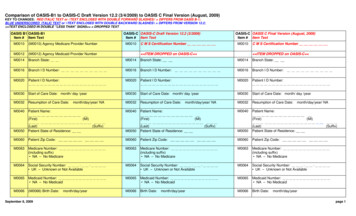
![OASIS-D Handouts [Read-Only] - Missouri](/img/30/oasis-d-powerpoint-2-slides.jpg)
